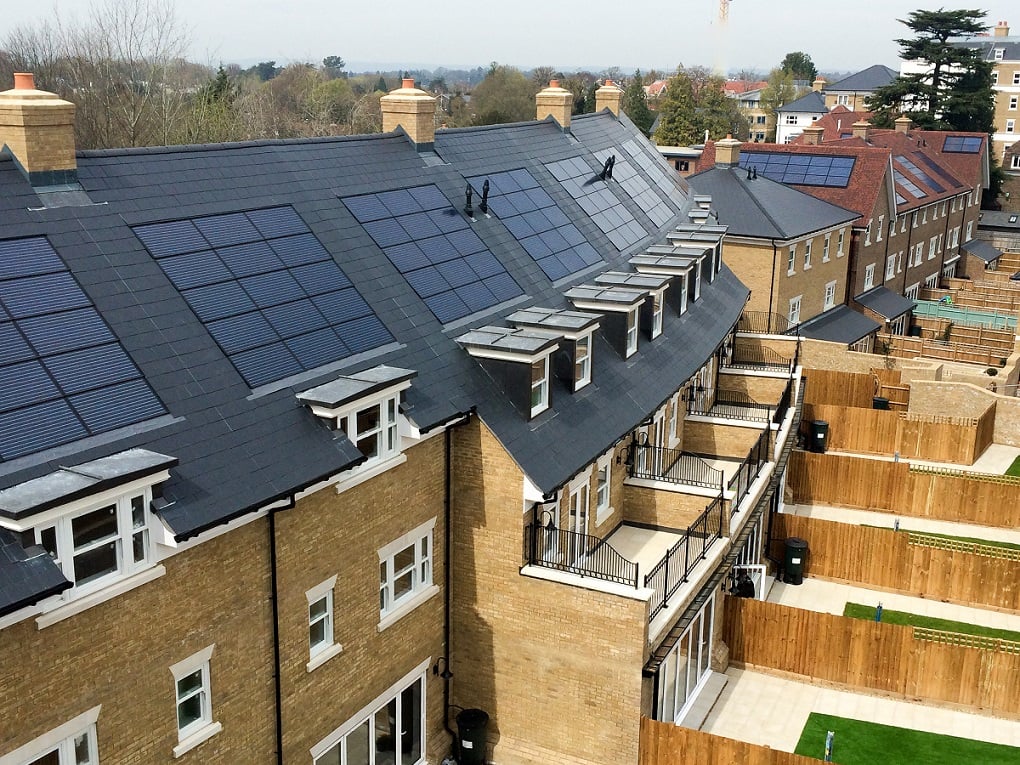
Image: Schweizer.
When rooftop solar just heated water, it was the renewable ugly duckling. Panels stuck out and colours clashed with surroundings. Now, the market is more demanding and housebuilders and architects are specifying solar PV equipment designed to appeal.
Technical advances have transformed the market and solar PV can now produce electricity locally so cheaply and efficiently that it’s a real alternative to fossil fuel-generated power. Improved battery storage, smarter inverters and more efficient, longer-lasting PV modules have expanded choice.
In parts of the world solar is cheaper than energy from coal. Already in the UK distributed solar is cheaper than retail electricity. In 10 years, PV could be the lowest-cost option almost everywhere, says Bloomberg.
New-build customers want total value, and that includes the way a product looks as much as how it works. We’ve seen this with smart phones, bicycles, PCs and electric cars.
Schweizer looked afresh at the problem and said ‘why not let the solar panels themselves be the roof?’ Sometimes the best solution is also the most attractive.
Solrif is an innovative, wholly integrated system that provides a compelling alternative to traditional roof tiles. We believe it’s the simplest, clearest solution and with more than 3 million Solrif-framed panels installed across Europe, it has become the proven leader in the growing in-roof solar market.
Solrif’s dual-purpose solution, in which solar panels double as weather-proofing roof tiles, provides the best carbon outcome as it avoids manufacturing something twice and the waste that involves.
While a radical improvement on traditional solar PV, Solrif comprises traditional construction materials – the main component being glass, used for hundreds of years as windows and facades, and aluminium for the frame.
Combining excellent solar energy yields with functional aesthetics, simple installation and moderate cost, this simple frame has become market leader in Switzerland and Europe and is increasingly popular worldwide.
A true alternative to conventional covers, Solrif helps reach minimum carbon compliance standards without costly special insulation or expensive windows for ‘passive building’ energy standards, so builders gain an ideal carbon offsetting tool for securing planning approval.
Many PV module manufacturers now offer their products with Solrif frames as a great alternative to standard bolt-on installations, at very little extra cost. Several now include terracotta colour options in cells and back sheets and frames, another popular option being all black panels.
With Solrif, solar PV can look like slate roofing or better, but at a fraction of the cost. In 15 years we’ve made tens of thousands of people happy with this patented product. And we’re encouraged to see the design innovator Tesla enter a growing market that we pioneered. We see this as a further endorsement.
At Schweizer, we put design at the heart of everything we do. The company has been active in solar since 1978. When Solrif won the Swiss Solar Prize for Best Integrated Solar in 2006, judges praised the future-proof design and complete integration, the roof comprising only PV panels, edge to edge.
Fully certified IEC 61215/61730, TÜV and MCS, Solrif is highly suitable for both new-build and renovation and often carries a lower insurance cost as the system is part of the building. It is supplied with a 10-year warranty and free, downloadable design software.
Schweizer is recruiting PV panel manufacturers and distribution partners in the UK and Ireland solar PV markets for Solrif and its MSP range of advanced solar mounting systems.
